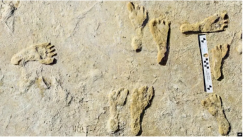
The tracks found at New Mexico’s White Sands National Park are turning upside down past assumptions on when humans first came into North and South America. They look like they were left behind just moments ago by a barefoot teen visitor to New Mexico’s White Sands National Park, each footprint freshly defined (描出外形) by sand. But this is no tourist track. These footprints are among the oldest evidence of humans in the Americas, marking the latest addition to a growing body of evidence that challenges when and how people first got into this unexplored land.
According to the research team, the footprints were pressed into the mua near an ancient lake at White Sands between 21, 000 and 23, 000 years ago, a time when many scientists think that huge ice sheets walled off human passage into North America.
Exactly when humans populated the Americas has been heatedly debated for nearly a century, and until recently, many scientists insisted that this first occurred no earlier than 13, 000 years ago. A growing number of discoveries suggest people were in North and South America thousands of years before. These include the Monte Verde site in Chile that is as old as 18, 500 years and the Gault site in Texas that is up to 20,000 years old. But each find kicks up a firestorm of controversy among scientists.
While the White Sands discovery doesn’t close the book on these debates, it is stirring excitement. “A discovery like this is very close to finding the Holy Grail (圣杯),” says Ciprian Ardelean, an archacologist at the Chiquihuite Cave in Mexico, where researchers believe they have evidence for human activity in the Americas as early as 30,000 years ago.
If confirmed, the discovery of people in the Americas during the last glacial maximum (末次盛冰期)would require a major change in scientifie thinking about how people arrived in the New Werld.
1. What is the previous conclusion on the first arrivals of Americas?| A.Humans came into Americas about 23, 000 years ago. |
| B.Humans first appeared in Americas to explore the land. |
| C.Humans didn’t arrive in Americas until 13, 000 years ago. |
| D.Humans couldn’t enter Americas because of White Sands. |
| A.To add evidence. | B.To introduce the background. |
| C.To give data. | D.To end the debate. |
| A.Excitement. | B.Argument. | C.Disagreement. | D.Interest. |
| A.Trustworthy. | B.Questionable. | C.Inspiring. | D.Disappointing. |
| A.Humans populated the Americas for nearly one hundred years. |
| B.The tracks were found at New Mexico’s White Sands National Park. |
| C.The footprints are among the oldest evidence of humans in the Americas. |
| D.Surprising footprints push back human arrival in Americas by thousands of years. |
Several large wooden constructions
First discovered in 1978,the site used
Researchers
Researchers believe
It seems inhuman to care more about a building than about people. That the sight of the Notre Dame's
It is not just the economy that is
However, the emotions are less about the building itself than about
And it will be rebuilt. It will never be the same, but that is as it should be.



